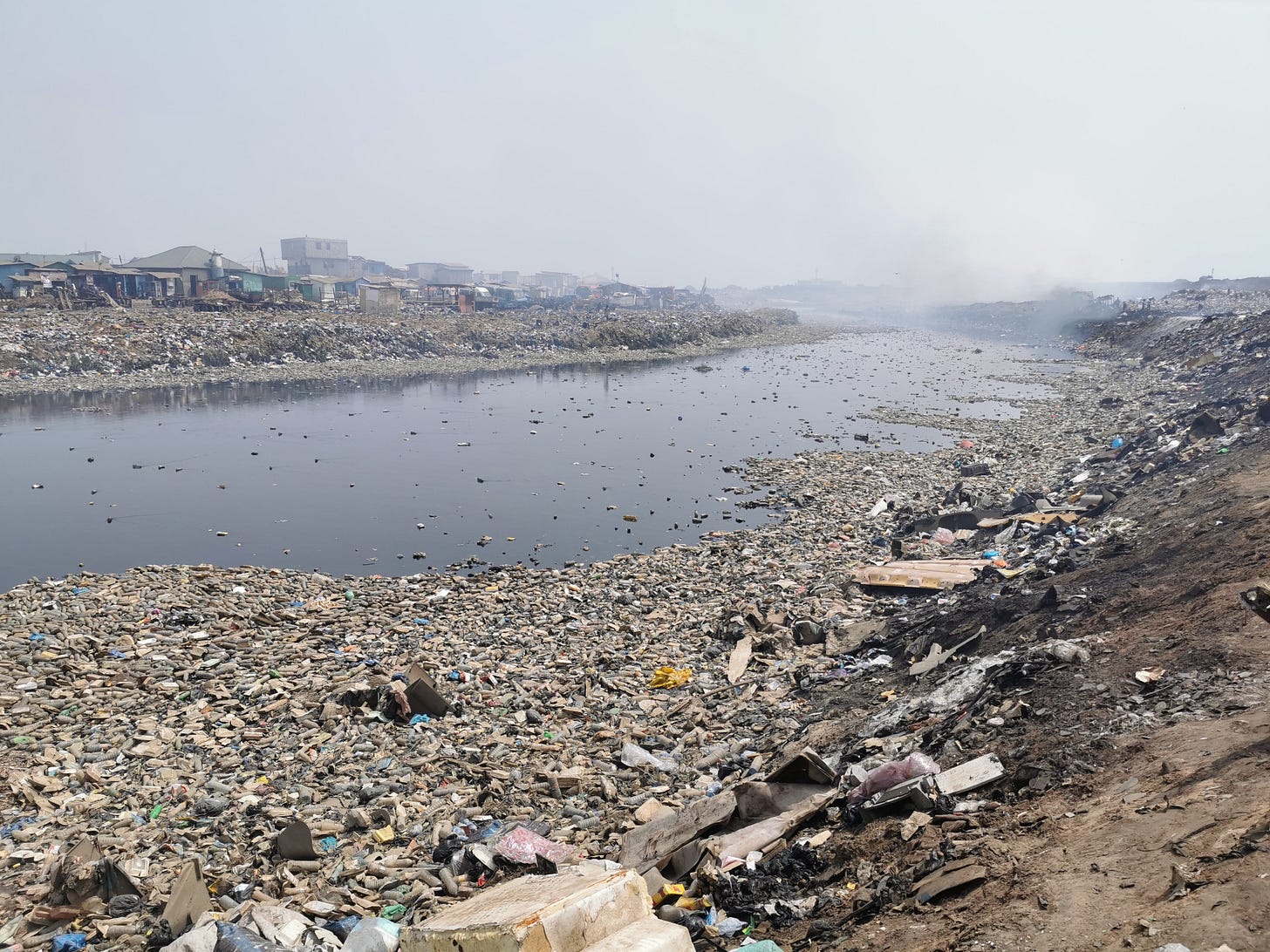
How the World Thinks
I have learned enough in my lifetime concerning pollution, greenhouse gas emissions, plastics, economics, poverty, and the effects of chemicals on the human body to gain the perspective I will share in this piece, though I am no expert on any of them. We often think of global warming as the most pertinent environmental threat to humans, a worry of mankind for at least 50 years. What worries me is that the focus of environmental destruction is still primarily set on global warming. That is not to say that global warming is not a concern, it is, but to not call as great attention to another problem which deserves as much, if not more regard, is irresponsible. It is hard to ignore the problem which is both visible and destructive, that brings poverty to the poor and accentuates mankind’s shift into the wretched abyss of short-term use products. Harm to our bodies, to those of animals, to every landscape, every city sidewalk and drain, to the bed of every body of water. I will discuss this today, what plastics do. Or rather, what they are made to do; we manufacture them, and it is worth speaking beyond the “environmental damage” scope of plastics, and consulting other effects, primarily on the human body.
It is right that I should start by covering what the world, the media, believes to be the largest environmental issues our planet is facing. Plastic pollution and plastic’s effects on the human body are under-considered when discussions of environmental harm arise, and they fly well under the radar, leaving many unaware of the plastic’s consequences. Lists like this, the “Six Most Pressing Environmental Issues,” lump chemical, heavy metal, air, water, and soil pollution into one category, yet it fails to mention plastic pollution. A second article from Unity College, “America’s Environmental College,” doesn’t even mention plastic pollution in their list of today’s five biggest environmental issues. A third article mentions plastic pollution as the fifth biggest environmental problem, but fails to mention the harms of plastics on the human body, and pushes the reader into guilt for environmental destruction and animal harm. Is food waste, third on the list, really a more pressing issue than the accumulation of plastics and related chemicals in our air, soil, and especially drinking water… and now even our blood and organs? I do not think so. Now to an individual who perhaps has more environmental influence than all of the above sources combined, let’s see what environmental activist-expert Greta T. is saying about plastic pollution: nothing. Rather, you will sometimes see her sport polyester clothing (made from plastic, from oil), discussing global warming. This is an opportunity Greta has to appeal to a larger audience and impart her expert knowledge upon many more, but she has not yet. Many still listen to her even though she is wearing fossil fuels on her skin, which strikes me as odd.
The Micro-lense of Plastic Pollution
Polyester deserves some time now, and I will delve into it a bit (I use the word polyester as a general term to describe all crude-oil-based polymer fabrics). It is made of crude oil byproducts and other harsh chemical solvents, and contains FTPs, PFAS, NPEs, flame retardants, phthalates, etc. Every time you wash polyester clothing, these chemicals, as well as micro-plastic fibers of polyester, are torn off the clothing and swept away in a rush of greywater and end up in our drinking water, our streams, lakes, and rivers, harming aquatic organisms. Only 95 percent of the microplastics in wastewater are removed at treatment plants, letting the rest flow back into natural water sources. These plastics do not degrade for a very long time, so they make their way up the food chain, biomagnifying, and eventually they are consumed by the seafood humans eat. And every time you work out and sweat, if you are wearing these polyester fabrics, as your pores open up, plastic and chemical molecules directly enter the body through skin. One should consider removing polyester, removing waterproof, removing synthetic leather from their wardrobe… removing what is not a “natural” fiber, and replacing them with “natural” fibers (wool, cotton, linen, or hemp, preferably organic for the latter three), or leather. I have, in the past year, slowly been removing these synthetic items from my wardrobe, and wearing mostly cotton and wool. If economically feasible, and considering the health risks at hand, it may be wise for you to do the same.
But what exactly happens when chemicals enter the skin through clothing or general plastic exposure? Well, a whole host of things may occur, with both males and females at risk of developing certain conditions and diseases. Males are at risk of estrogenization, infertility, and decreased sperm quality and quantity; these adverse aberrations can lead to feminization with lowering testosterone levels. The risk for females is similarly alarming, including the potential development of ovarian cysts or PCOS (polycystic ovarian syndrome), a disease that may be becoming more frequent (especially with rising obesity rates) that is strikingly attributed to plastics and the endocrine disruption they cause. Obesity and infertility too are becoming increasingly prevalent among females (and obesity is likely not a disease naturally caused by genetics—it is epigenetic, caused by environmental changes to genes. Click here to see more.)
The looming infertility crisis (at least 10 percent of people are now infertile worldwide) is growing, and plastics are playing a major role. Male infertility and testicular disease, as well as female ovarian diseases, are now becoming inheritable and present at birth, and male sperm counts have decreased by 53 percent since 1973. Limiting exposure to polyester, plastic bottles and containers, plastic food storage containers, plastic bags, cling wrap and other plastic wraps, plastic cutlery, and canned foods and beverages (often lined with plastics) will be beneficial in ensuring the body is not exposed to, and accumulating, toxic chemicals, the vast majority of which enter through the skin or through diet. Keep in mind, the average person consumes a credit-card-sized amount of plastic a week. There may be a large number of changes to make, so one I suggest starting with is no longer touching receipts—nearly all contain BPA or BPS (Bisphenol A or Bisphenol S) as a thermal coating, both of which are strongly linked to reproductive and hormonal harm, obesity and diabetes, and breast, ovarian, and prostate cancers.
The Macro-lense of Plastic Pollution
Stepping aside, a much wider net can be cast in discussing plastic pollution. The human body is important, and we ought to protect our own, just as we ought to protect those who live despondently in the third world. We ought to do our part in protecting the African and Southeast Asian countries that are currently choking on waste, and that starts with the first-world consumer, and the demands of the consumer must change: less cheap and/or disposable plastic products and plastic clothing. Fast fashion produced in the third world is now synonymous with waste, and much of the clothes produced there, which often end up discarded or unwanted, are made of cheap polyester, nylon, or blended with cotton. Not only are these poor countries producing, but they are also taking in first-world plastic, and they are mismanaging this waste at extremely high levels. Workers are paid close to nothing to be exposed to these materials and their related toxins, and of course, as we have all seen at one point or another, the poor rivers of the sub-first-world are teeming with bright-colored shards, and caps and bags… modern aquatic life.

It is the poor Kenyan who sifts around the putrid Dandora Landfill, as this Emirati article explains, joined by birds, that the first world needs to change their demands for. The Kenyan sees in front of him only acres upon acres of plastic waste. Yet not all the waste in these regions is due to first-world demands: plenty of plastic in Asia and Africa is produced domestically or imported for use, where they inevitably end up in the same landfills as the first-world’s waste. Populations are skyrocketing in the third world, and right beside it is plastic production (and imports) to quench the needs of tens of millions. It is a shame that many sub-Saharan African and South Asian countries are developing at this time when plastics are so widely used, as these regions are the world’s fastest-growing in waste production, and they certainly lack the facilities to manage this waste. Much of the waste is burned, leaving toxins in the air to poison the lungs of the paupers.
Final Words
Plastic pollution deserves to be acknowledged alongside global warming regarding the world’s most threatening environmental issues. At least. I consider it the most threatening issue, due entirely to the grotesqueness of seeing plastic everywhere (the “aesthetics” to be seen of Earth are sadly forlorn, and cities of grand and opulent architecture have now succumbed to crude-oil poverty. Neither myself, nor the reader, have had, now have, or perhaps will have the luxury to experience these cities without the invasion of wretched foreign vagrants—synthetic plastics, starting with bakelite), its literal omnipresence, and the effects of plastics and related chemicals on the human body. Focusing on this third point, I am afraid most of you reading this were unaware of the harmful effects of plastics on your body, or even on your potential offspring. As we have seen recently, the chemicals used to make plastic are very toxic themselves, such as vinyl chloride (the “-VC” in PVC) spewing out of train cars in Eastern Ohio in a train derailment incident akin to Chernobyl (see images here). We must, as the first world, curtail our demand for plastic products and cheap clothing, and demand reusable products, metal or glass, or clothing of natural fibers that will last many years. The trend of “recycled polyester clothing” is no step towards progress. The world looks vile when rife with plastic, and the most picturesque, perhaps secluded parts of Nature can be found contaminated with plastic along river banks, or chemicals in the soil. The rivers of the third world, mainly, are clogged arteries; so is their land lumped with fat. Our seas and oceans, the Great Pacific Garbage Patch… Earth and humanity we have burdened with this. Students at Connecticut College are burdened: the school switched to “sustainable,” sturdy plastic food containers, our blue Conn-tainers. Just because they are “microwave safe” does not mean they are phthalate-free, just because they are Bisphenol A (BPA) -free does not mean they are Bisphenol-free. I would prefer a plastic-free world (I must be dreaming), or at least a world where plastic use is decreasing and waste is being disposed of accordingly, than a world where the ocean levels are not rising, where ice sheets are not melting, where CO2 and methane emissions are not increasing and causing global warming. I am concerned if anyone who is deeply concerned about the planet does not think the same.





A great insight into a less discussed and yet very important environmental issues.
Wow. Quite a sobering piece and had no idea this is the case.